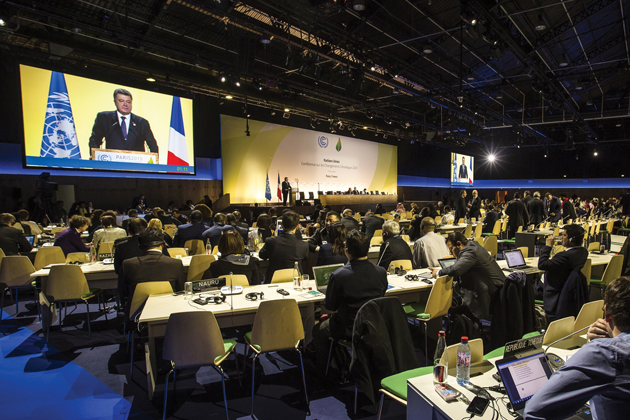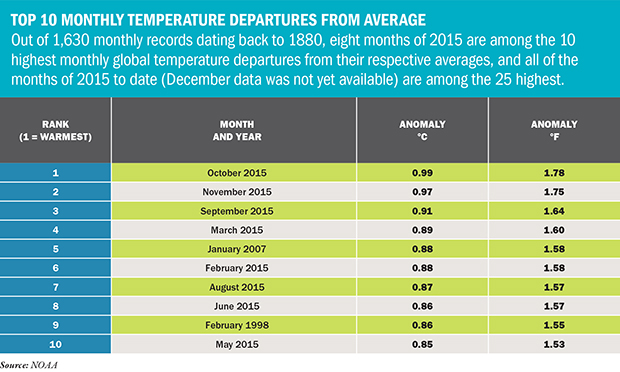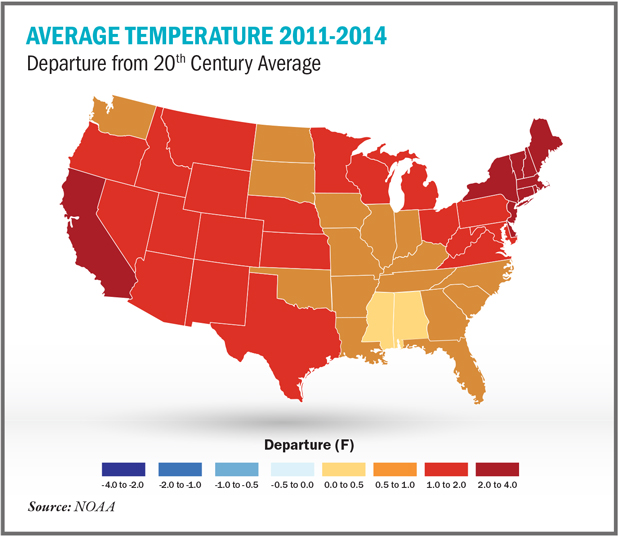
In December, representatives from 195 countries convened in Paris for a United Nations climate conference, ultimately producing an agreement heralded by many as one of the most significant developments in the international community’s approach to climate change.
The accord aims to keep global warming below 2°Celsius, the threshold at which most scientists agree that the most serious effects of global warming become inevitable. All the nations pledged to gradually reduce greenhouse gas emissions and take other steps to mitigate their contributions to the problem. Wealthier nations also committed to providing financial support to developing countries and those most affected by global warming to help them meet the goals and mitigate the damage.
Former Vice President Al Gore said the agreement “gives us an excellent chance of accelerating the measures that could actually bring us to a point where we can start stabilizing the climate.”
While the agreement is non-binding, it marks the first time nearly every country has committed to lowering greenhouse gas emissions to help stave off the most drastic effects of global warming. Previous measures have required action among developed countries to reduce emissions, but exempted developing countries such as China and India, which are top emitters but have historically fought to retain that freedom in order to pursue their economic development goals. The near-universal acceptance of the treaty and the 2° Celsius cap—and an expressed desire to limit the increase to 1.5°Celsius above pre-industrial levels—highlights the emerging ubiquity of grave concern and prioritization of climate change.
While it will affect both domestic and international policies, the Paris agreement is meant to serve more as an economic signal than as a binding statute. “It will help the world prepare for the impacts of climate change that are already here and also for those we know are now headed our way inevitably,” said U.S. Secretary of State John Kerry. He added that the measure also sends “a critical message to the global marketplace” to invest in green energy.
The conference and resulting accord could not have come at a better time—or a worse one in terms of the current climate. According to NOAA’s National Centers for Environmental Information, December also closed out the warmest year in the 136-year period of record, marking the second consecutive year of record-breaking global average temperatures. In the United States alone, December saw record warmth of 6°F above the 20th century average. The annual average temperature in the United States was 2.4°F above the 20th century average, making 2015 the second warmest year on record, checked slightly by the extreme cold early in the year.
The year not only saw 10 out of 12 months of record heat for their respective months—a record number of broken records in and of itself—but many of the greatest anomalies. At 1.78°F above average worldwide, October 2015 was the warmest month ever compared to average, out of a total of 1,630 months. Globally-averaged land surface and sea surface temperatures were 1.55°F and 2.30°F above average, respectively, surpassing all previous records. November came in a close second, at 1.75°F above the 20th century average across global land and ocean surfaces, and became the seventh consecutive month a monthly global temperature record was broken. In its report that month, NOAA wrote that the December global temperature would have to be at least 1.46°F (0.81°C) below average—or 0.43°F (0.24°C) colder than the current record low December temperature set in 1916—for 2015 to not become the warmest year recorded.

In early November, the Met Office, Britain’s national weather service, and NASA both reported that the Earth’s average temperature was likely to rise 1°C above pre-industrial levels for the first time by the end of 2015, halfway to the critical 2° Celsius benchmark. Since 2000, global monthly heat records have been broken 32 times, yet the last time a monthly cold record was set was in 1916, according to CBS News.
Some of the heat is likely due to a strong El Niño event in the Eastern Pacific that continues to gather strength. Experts say the 2015 El Niño is one of the three strongest ever seen, but cannot account for all of the year’s warmth, as 13 of the 15 warmest years on record have occurred since 2000. Rather, it is the combination of long-term warming and the strong El Niño that pushed Earth toward its second consecutive warmest year on record.
“Rising global temperatures should be a concern to us all as it will lead to rising sea levels, more frequent droughts and extreme wildfires,” said Megan Linkin, natural hazards expert and vice president of global partnerships at Swiss Re. Here in the United States, she added, some of the most imminent and severe impacts will focus on areas like Miami and South Florida, the South West and California, but the warming climate and resulting extreme weather are already impacting every state through drought, powerful storm systems, tornadoes, heavy snow and ice, and flooding.

In Aon Benfield’s 2015 Annual Global Climate and Catastrophe Report, the company reported that 31 events with economic losses exceeding $1 billion billion-dollar loss events had occurred in 2015, 11 of which hit the United States. Severe, persistent drought continued to plague the western United States, with total economic losses surpassing $4.5 billion in the firm’s year-end estimation, while severe weather, flooding and wildfires all presented billion-dollar loss events throughout 2015. Throughout most of the year, experts projected the lowest natural catastrophe losses in the United States since 2007. In the last week of December, however, an outbreak of severe weather including tornados, severe thunderstorms, heavy snow and flooding added at least $1 billion in further damage, pushed the aggregated 2015 economic loss above the 15-year average of $16 billion, according to Aon Benfield.
The insurance industry has dodged much of the burden of global natural catastrophe losses this year, with the most damaging events largely striking regions with historically low insurance penetration. While increasingly severe disasters may represent a selling point to boost policy sales in some of these markets, the continued worsening in weather will make all regions far more likely to suffer a range of these extreme events—and see increasingly costly claims.
“Climate change does not see borders or wealth, so regardless of insurance penetration, all areas of the world can expect to see a steady increase in natural catastrophe losses over the long term,” Linkin said. “History shows us that, as a rule of thumb, natural disaster losses roughly double every 10 years. Furthermore, our preliminary sigma estimates for 2015 show that only a third of these natural catastrophe losses were covered by insurance.”
